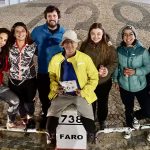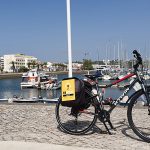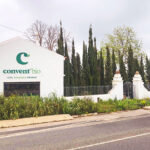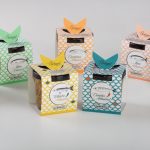Exotic invasive macroalgae on the coast are becoming an environmental problem throughout Europe. On the Algarve coast, we can increasingly observe large quantities of them, which may indicate imbalance in the marine ecosystem.
WORDS Ylenia Pedraza Bermúdez
Exotic invasive macroalgae are occupying the space of native macroalgae on rocky substrates. The most well-known is Rugulopteryx okamurae and its uncontrolled reproduction has increased in recent years. But it is not the only macroalgae to be growing at alarming speed.
The invasion of these species hampers the benefits of the ecosystem provided by the coast, including the marine biodiversity sector, fishing and tourism. This indirectly affects the local economy and the blue economy. It has now become an environmental problem in the Algarve, hence the need to find solutions for marine conservation and preserving the coastal ecosystem.
Native macroalgae are actually of benefit to the ecosystem. Macroscopic autotrophic organisms act as natural barriers that reduce the destructive force of waves and protect the coastline. Additionally, they contribute to carbon fixation, either naturally or due to human activity.
Macroalgae also produce organic matter and energy, maintain water quality and stabilise the marine substrate (Lara et al., 2008).
Invasive alien species (IAS) are those introduced into a natural ecosystem or habitat, acting as agents of change and posing a threat to native biological biodiversity. The introduction of IAS is considered the second leading cause of biodiversity loss globally (Genovesi P. & Shine C., 2004).

The importance of marine biodiversity
Marine biodiversity is necessary for the development of sustainability – economic, social and environmental – which maintains the health of the planet and provides us with services that promote human health, well-being, and prosperity (VVAA, 2005).
How do invasive species reach the beach?
Alien invasive macroalgae reach the beach through maritime transport. This occurs in two ways:
Biofouling is a natural phenomenon that involves the accumulation of living organisms on submerged artificial surfaces or those in contact with water, such as ship hulls, breakwaters and docks.
Ballast water is used by ships to compensate for the weight loss caused primarily by cargo discharge. Thus, the uptake and discharge of this water occurs mainly in port areas, allowing for loading and unloading operations on ships.
Once they arrive, invasive macroalgae colonise subtidal areas. They can be found from the intertidal region to the shallow subtidal, both on rocks and epiphytes, and form natural vegetation belts along exposed coastlines. With the influence of lunar phases, during the full moon, high and low tides are more intense. During low tide, invasive macroalgae present on rocky substrates which are exposed to waves. The waves break, separating the macroalgae from the rocks, and currents carry them towards the shoreline, where they accumulate.
“The introduction of invasive species into aquatic environments triggers important changes that propagate through the food chain and cause a reduction in the abundance and diversity of species.” (Global Change Biology, 2016)
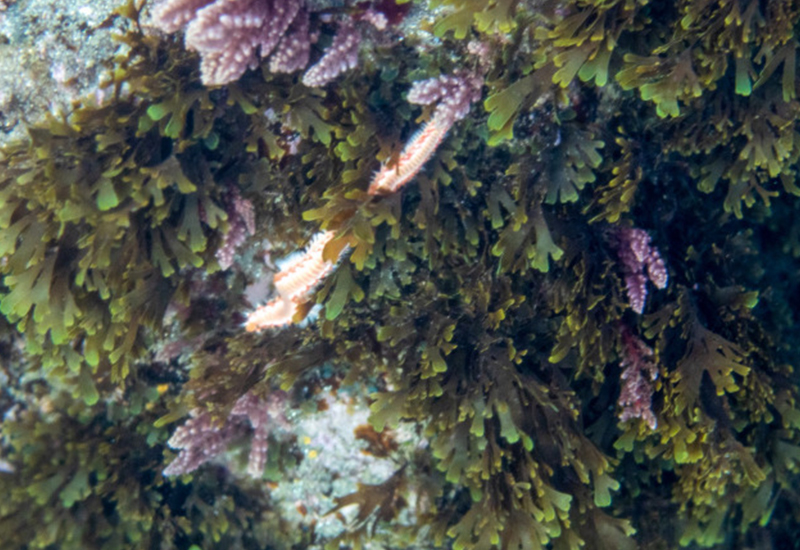
The impact of invasive species
The main impact is the genetic contamination and loss of marine biodiversity. In the long term, there is a change in species structure and composition, genetic contamination, and the release of very high amounts of secondary metabolites, including phenolic compounds (Carpenter et al., 2000), which are toxic to marine biodiversity. Their high fecundity, growth rate, and dispersal capacity lead to an increase in the number of species.
Possible solutions
This environmental problem should be addressed in the long term with maritime policies and strategies that prevent the introduction of invasive macroalgae. Additionally, in other countries, short-term measures are being taken to remove accumulations of these macroalgae, aiming at the production of biogas, biodegradable packaging or composting. Additional resources are currently being investigated.
Ylenia is the environmental educator for SOMAR – Marine Conservation and Bioacoustics Association
Sources:
Gallardo, B., M. Clavero, M. I. Sanchez & M. Vilà. Global ecological impacts of invasive species in aquatic ecosystems. Global Change Biology. DOI: 10.1111/gcb.13004
Genovesi P. & Shine C. (2004). European Strategy on Invasive Alien Species. Council of Europe. Nature and environment. 137. 1-59.
Lara-Lara, J.R. et al. (2008). Los ecosistemas costeros, insulares y epicontinentales, en Capital natural de México. Ensenada Center for Scientific Research and Higher Education. 1. 109-134.
VVAA. (2005). Ecosystems and human well-being, Millennium Ecosystem Assessment. Island Press. 1-101.
Exotic Invasive Macroalgae in the Algarve: Rugulopteryx okamurae (E.Y. Dawson) I.K. Hwang, W.J. Lee & H.S. Kim, 2009 Asparagopsis armata, Harvey 1885 Asparagopsis taxiformis (Delile), Trevisan de Saint-Léon, 1845 Codium fragile (Suringar) Hariot, 1889 Caulerpa prolifera (Forsskål) J.V.Lamouroux, 1809






